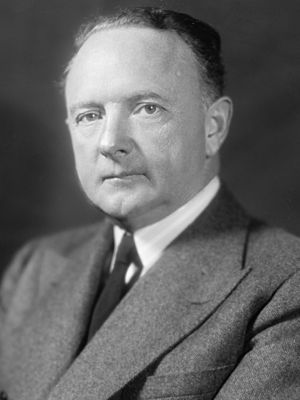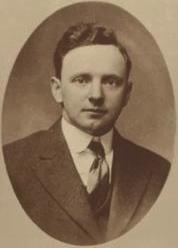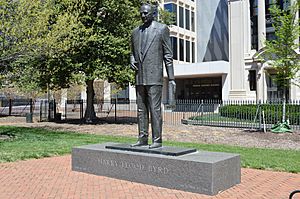Harry F. Byrd facts for kids
Quick facts for kids
Harry F. Byrd
|
|
|---|---|

Byrd, c. 1926–30
|
|
| United States Senator from Virginia |
|
| In office March 4, 1933 – November 10, 1965 |
|
| Preceded by | Claude A. Swanson |
| Succeeded by | Harry F. Byrd Jr. |
| 50th Governor of Virginia | |
| In office February 1, 1926 – January 15, 1930 |
|
| Lieutenant | Junius Edgar West |
| Preceded by | Elbert Lee Trinkle |
| Succeeded by | John Garland Pollard |
| Member of the Virginia Senate from the 26th district |
|
| In office January 9, 1924 – February 1, 1926 |
|
| Preceded by | James M. Dickerson |
| Succeeded by | Joseph S. Denny |
| Member of the Virginia Senate from the 10th district |
|
| In office January 12, 1916 – January 9, 1924 |
|
| Preceded by | Frank S. Tavenner |
| Succeeded by | Marshall B. Booker |
| Personal details | |
| Born |
Harry Flood Byrd
June 10, 1887 Martinsburg, West Virginia, U.S. |
| Died | October 20, 1966 (aged 79) Berryville, Virginia, U.S. |
| Political party | Democratic |
| Spouse |
Anne Douglas Beverley
(m. 1913; died 1964) |
| Children | 4, including Harry Jr. |
| Signature | |
Harry Flood Byrd Sr. (June 10, 1887 – October 20, 1966) was an American politician. He served as Virginia's governor from 1926 until 1930, then represented it as a U.S. Senator from 1933 until 1965.
Byrd strongly opposed racial desegregation of the public schools. He was the leader of a campaign of opposition to the U.S. Supreme Court decisions in Brown v. Board of Education.
Contents
Early life and education
Harry Flood Byrd was born in Martinsburg, West Virginia, in 1887. He was the son of Eleanor Bolling (Flood) and Richard Evelyn Byrd Sr.
Byrd's father became a wealthy apple grower in the Shenandoah Valley and published the Winchester Star newspaper. Harry initially attended the public schools, but received most of his education from the private Shenandoah Valley Academy in Winchester.
Marriage and family
Byrd married Anne Douglas Beverley, a childhood friend, on October 7, 1913. They lived with her parents in Winchester until 1916, when he built a log cabin, named Westwood, in Berryville at a family-owned orchard, and they moved there. The cabin was constructed from chestnut logs and remains one of the few examples of natural chestnut bark existing in the United States due to the chestnut blight. The Byrds had three sons: Harry F. Byrd Jr. (1914–2013), Bradshaw Beverley Byrd (1920–1997), and Richard Byrd (1923–2009), and one daughter, Westwood Beverly Byrd (1916–1952). In 1926, Byrd purchased Rosemont Manor, an estate outside Berryville, adjacent to the family apple orchards. The family moved into the antebellum mansion in 1929, at the end of Byrd's term as governor.
Business career
In 1903, Harry Byrd took over his father's newspaper, the Winchester Star. He eventually bought the Harrisonburg Daily News-Record and several other papers in the Shenandoah Valley. His family operated these papers until April 1, 2018, when they were sold to the Ogden Newspapers Inc. of Wheeling, West Virginia.
In 1907, he founded The Evening Journal in nearby Martinsburg, West Virginia. He sold the paper in 1912 to associate Max von Schlegell.
In 1908, at the age of 21, he became president of The Valley Turnpike Company, overseeing the Valley Turnpike, a 93-mile (150-km) toll road between Winchester and Staunton. He held that office for seven years until his election to state office.
Byrd also owned extensive apple orchards in the Shenandoah Valley and an apple-packing operation which was among the largest on the East Coast.
Virginia politics
In 1915, Byrd was elected to the Virginia Senate. That election was to begin his 50 years of service in various roles in the state and federal government.
Byrd was a member of the Senate Committee on Roads, the Finance Committee, the Steering Committee, the Committee on Privileges and Elections, and the Committee of Schools and Colleges. He advocated a tax on gasoline as a fair method of raising revenue for road construction.
He was elected Governor of Virginia in November 1925, easily defeating Republican Samuel H. Hoge in the general election.
As governor, serving a term from 1926 to 1930, Byrd pushed through constitutional amendments that streamlined the state government and allowed for more efficient use of tax dollars. He also made property taxes solely a county responsibility.
He instituted a "pay as you go" approach to spending, in which no state money was spent until enough taxes and fees came in to pay for it. Highways and tourism were his primary pursuits. During his tenure, roads were built to Jamestown and Monticello and historical markers appeared along roadways.
Education was not on his agenda, and state spending for public schools remained very low until the late 1960s. Byrd became one of the most vocal proponents of maintaining policies of racial segregation. Byrd authored and signed the "Southern Manifesto" condemning the 1954 U.S. Supreme Court decision in Brown v. Board of Education. His call for "massive resistance" against desegregation of public schools led to many Virginia schools closing rather than be forced to integrate.
National politics
In 1933 Byrd was appointed to fill a vacancy in the United States Senate; he won reelection as a Democrat in 1933, 1934, 1940, 1946, 1952, 1958, and 1964.
By the 1950s Byrd was one of the most influential senators, serving on the Armed Services Committee, and later as chairman of the Finance Committee. He voted against public works bills, including the Interstate Highway System, and played a key role in the passing of the 1964 Revenue Act.
Byrd retired from the Senate for health reasons in November 1965. His son, Harry F. Byrd, Jr., was appointed his successor.
U.S. presidential candidate
Although Byrd never again formally sought the presidency nor became his party's candidate, Southern Democrats drafted him in several campaigns between 1944 and 1960.
Death
Shortly after leaving office, Byrd died in 1966 from a brain tumor; he had been in a coma for four months. He was 79 years of age and had been a Senator for over 32 years. He was interred in Mount Hebron Cemetery in Winchester.
Legacy
Possibly his greatest legacy was the creation of Shenandoah National Park, as well as the Skyline Drive, the Blue Ridge Parkway, and the Virginia state park system.
The Blue Ridge Parkway bridge over the James River in Big Island, Virginia was named and dedicated to him in 1985.
On November 26, 1968, the Virginia State Highway Commission named Virginia State Route 7, a historic road which travels from Alexandria past Berryville to Winchester, as "Harry Flood Byrd Highway" between Alexandria and Winchester. The name is still in use between the Shenandoah River and Leesburg. Byrd's home from 1926 until his death, Rosemont Manor, is now open to the public as a bed and breakfast, as well as event venue.




